

 Vol. 40 (Number 21) Year 2019. Page 10
Vol. 40 (Number 21) Year 2019. Page 10
GAISINA, Lyutsiya M. 1; SHAYKHISLAMOV, Rafael B. 2; SHAYAKHMETOVA, Rimma R. 3; KOSTYLEVA, Elena G. 4; GOREMYKINA, Lilia I. 5 y GAINANOVA, Albina G. 6
Received: 20/02/2019 • Approved: 03/06/2019 • Published 24/06/2019
ABSTRACT: The phenomenon of a healthy lifestyle is characterized by some special features. Very different, sometimes conflicting needs underlie the basis of the behavior associated with health. That leads to certain difficulties in considering this issue. At the same time, a significant part of the types of behavior that have an impact on health is conditioned by the motives that are not related to health. In this regard, the most important task for sociologists is to study actively the health of the most intellectually advanced group – students. |
RESUMEN: El fenómeno de un estilo de vida saludable se caracteriza por algunas características especiales. Las necesidades muy diferentes, a veces conflictivas, subyacen en la base del comportamiento asociado con la salud. Eso lleva a ciertas dificultades al considerar este tema. Al mismo tiempo, una parte significativa de los tipos de comportamiento que tienen un impacto en la salud está condicionada por los motivos que no están relacionados con la salud. En este sentido, la tarea más importante para los sociólogos es estudiar activamente la salud de los estudiantes más avanzados intelectualmente. |
Good health is the key prerequisite for an individual to implement his/her biological and social functions. It is the basis of personal self-actualization, adaptation and socialization. Student health nowadays is the major focus of attention, since there are eight hundred sick students per thousand examined ones. A.S. Vlasenko, A.V. Zharova, V.A. Medic (Vardomatsky, 1989) and others consider students as a special social group and pay attention to their specific position in society, which "today is particularly controversial. It means that high educational status is often combined with the position of an extra person." N.A. Bezrukikh considers students in terms of professional future and considers students to be "a specific community of people, organizationally united by the institute of professional education and characterized by the formedness of attitudes to the future profession" (Bezrukikh, 2007; Abaskalova, 2001). The characteristics of modern students stem from their value orientations and life attitudes. So the value hierarchy of students, according to the research results of A.P. Vardomatsky looks as follows: 1) health, 2) love (mutual), 3) happy family life, 4) work as creativity, 5) children, 6) beauty (of nature, human art), 7) communication, 8) spiritual freedom (the ability to freely express opinions, publish them in press, etc.), 9) material freedom (the ability to realize reasonable needs based only on one’s resources, independence from parents’ money), 10) public recognition, 11) work as a means to do good to people, 12) work as a means “to immortalize oneself” (personal immortality), 13) things as “conditions” (things that are necessary for productive work), 14) impressions, 15) work as a means of earning, 16) pleasures, 17) things that mean “comfort” (a good apartment, a cottage, a car, etc., providing a comfortable material environment), 18) power (the feeling that the course of important events, the fate of people, etc. depend on one’s decisions), 19) glory, 20) prestigious things (good things that give a sense of self-confidence) (Vardomatsky, 1989; Avdeeva, Ashmarin, Stepanova, 2000). S.I. Popov was engaged in the analysis of the "quality of life" category in his works. According to S. I. Popov, the phrase "quality of life " was first publicly used by the US President L. Johnson who said that goals of the American society cannot be measured only by the size of bank deposits, but must be determined by the “quality of our people’s life”. Popov does not imply only economic sense by the category of quality of life, but also the socio-political situation in a country, self-awareness of an individual and the level of morality in society (Gaisina, Barbakov, Koltunova, Shakirova, Kostyleva, 2017; Sekerin, Gaisina, Shutov, Abdrakhmanov, Valitova, 2018; Averin, 2008).
A healthy lifestyle is not just everything that is beneficial to people's health. In this case, we are speaking about all the components of different activities aimed at the care and improvement of health. We point out that healthy lifestyle is not limited to such forms of medical and social activities as bad habits elimination, adherence to hygienic norms and rules, health education, applying for medical care or consultation in medical institutions, compliance with the regime of work, rest, nutrition, etc. The main aspects of human health problems are of biological and social origins. Here belong correlation between social and biological in an individual, development and self-development, and other aspects revealing the gene pool concept (its nature and implementation), the state of the environment (natural, social, industrial), lifestyle in a broader sense (culture of labour consumption, quality of vocational rehabilitation), healthy lifestyle formation (food culture, motor activity, bad habits, interpersonal relationships, etc.). All these aspects should be considered at the philosophical methodological level, which determines the conceptual importance of scientific research (Gaisina, Mikhaylovskaya, Khairullina, Ustinova, Shakirova, 2015; Gaisina, Bakhtizin, Mikhaylovskaya, Khairullina, Belonozhko, 2015; Akchurin, 2006).
The tools of the sociological survey are based on the objectives of the survey and represent a questionnaire. The questionnaire consists of 5 blocks of questions, each of which works to solve a specific research problem. Students of the city of Ufa took part in this enquiry. Sociological survey “Ufa students’ attitude to their health” was conducted in 2017 by the Department of Sociology and Youth Work of Bashkir State University. The researchers made use of non-random quota sampling with unrelated parameters and distribution by gender, year of studies, education specialty (humanitarian, scientific, technical), forms of education (free of charge or fee-paying basis). This included students of various universities and years of study: Ufa State Aviation Technical University, Ufa State Petroleum Technical University, Bashkir State University. The total number of the selected units amounted to 1450 in Ufa, with 740 young female students and 710 males.
A new paradigm of health is clearly and constructively defined by the academician N. M. Amosov: “Only their own persistent and significant efforts make people healthy. These efforts cannot be replaced by anything else” (Amosov, 1987).
Only 6% of the total respondents are not drinking alcohol at the time of the survey. This is a large proportion of those who drink alcohol once a week and more often. The frequency of alcohol consumption by the respondents is represented in Figure1.
Figure 1
Alcohol consumption, (%)
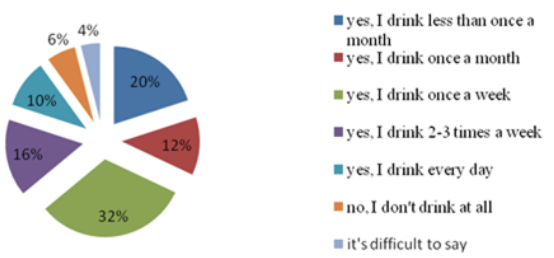
Source: based on the sociological survey
Figure 1 shows that 96% of the respondents consume alcohol. Half of the respondents (46%) often (once a week and more often) consume alcoholic beverages.
The survey found out that 68% of respondents have taken drugs (72% are males, and 28% are females).
During the survey, some respondents admitted that they are still using drugs (2% of the respondents).
Almost a third of the respondents (28%) reported positively to the question “Are there any drug users among your acquaintances?”
In the course of the survey we have established the degree of awareness about health issues among the respondents. It turned out that mostly young male respondents do not need additional information on the ways of maintaining their health. Girls, on the contrary, believe that they need additional information about their health. The distribution of the answers by gender to the question: “Do you need any information on the ways of improving your health?” is presented in Figure 2.
Figure 2
Respondents’ interest in additional information
on improving their health, by gender, (%)
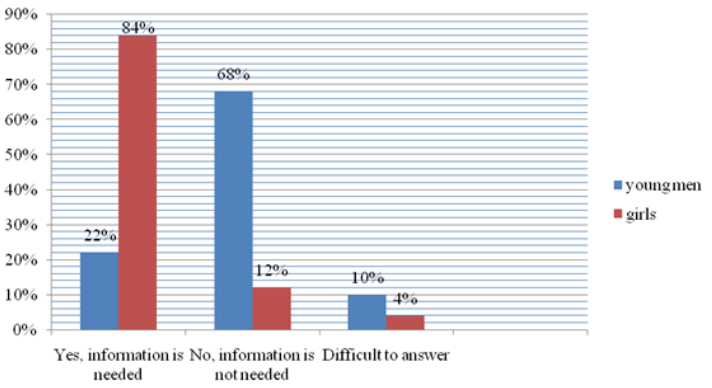
Source: based on the sociological survey
Dependence on gender can also be traced in the range of issues that students tried to get more information about. So, for girls, information on “proper nutrition” turned to be more relevant - 16%, “healthy lifestyle” - 20%, and “psychology of communication” - 22%.
For young men, the most pressing problems of healthy lifestyle were as follows: physical training - 10%, healthy lifestyle - 14%, eliminating bad habits - 20%.
The distribution of the respondents' answers by gender is presented in Figure 3 and the accompanying Table 1.
Figure 3
The most topical information on health for the respondents by gender, (%)
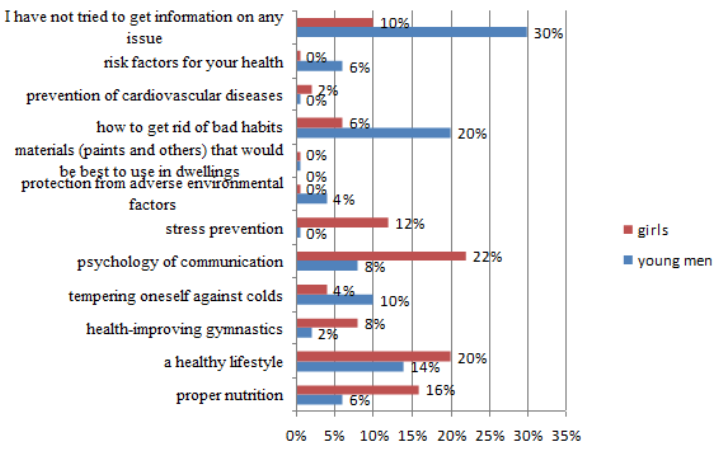
Source: based on the sociological survey
-----
Table 1
The most topical information on health
for the respondents by gender, (%)
Questions about health / gender |
Young men |
Girls |
proper nutrition |
6 |
16 |
healthy lifestyle |
14 |
20 |
health-improving gymnastics |
2 |
8 |
cold acclimation |
10 |
4 |
psychology of communication |
8 |
22 |
stress prevention |
0 |
12 |
protection from adverse environmental factors |
4 |
0 |
materials (paints, etc.) that would be best to use in dwellings, because they are harmless |
0 |
0 |
how to get rid of bad habits |
20 |
6 |
prevention of cardiovascular diseases |
0 |
2 |
health risk factors |
6 |
0 |
I have not tried to get information on any issue |
30 |
10 |
Total |
100 |
100 |
Source: based on the sociological survey
The survey identified the sources of information on health that the respondents applied to for the last time. The Internet has become the most popular source of information on health - 44% of respondents chose this answer. The second most common answer was television (20%). The third most popular answer was “Conversations by relatives and friends” (16%). 8% of the respondents heard such information on the radio, 8% of the respondents saw it in print media. 4% of the respondents found it difficult to answer. None of the interrogated students reported “At the university lecture (another educational institution)”. This fact is not surprising, since no one answered in the affirmative to the question “Is there any discipline at your university or a special course dealing with health problems?”.
The features of the respondent interaction with health care institutions were identified when studying the factors that affect student´s’ healthy lifestyle. A significant part of the respondents seek medical help either when they feel unwell for several days or when they need a medical certificate (medical examination certificate, sick-leave, etc.). No dependence on the respondent´s gender or age has been revealed in this case.
Reasons for visiting doctors in medical institutions by students are depicted in Figure 4.
Figure 4
Reasons for visiting doctors in medical institutions by students (%)
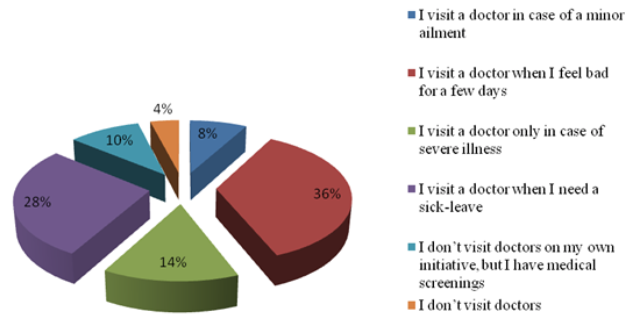
Source: based on the sociological survey
The results of the authors’ survey were compared to the results of the surveys on students’ health conducted in Ufa in 2017 (Shayahmetova R.R., 2017). The survey revealed low medical activity of the respondents: almost three-quarters of males and about 70% of females visit a doctor when there is a risk of a neglected disease and complications, only 1.3% of the students voluntarily visit a doctor for preventive medical examination, 16.8 % of students do not visit doctors at all. Less than half of students regularly undergo preventive examinations (41.5%).
This enables us to make a conclusion that; in general, the trend of low activity of students in seeking medical help in Ufa persists.
However, not all the respondents have a health insurance policy in place. 78% of the respondents answered positively to the question “Do you have a health insurance policy?” (100% of policies are the mandatory ones which provide free medical care), 22% of the respondents have no policies. Thus, among students there are those who are not worried about getting free medical care policy. During the university years the students’ health deteriorates, as a rule. Regarding the current situation, more public institutions should be involved, and the priorities and functions of the education system are to be reviewed. Studying is natural for young people, thus, activities on shaping healthy lifestyle, as well as teaching them self-protection behavior, can easily fit into the education process. Educational impact is essential to this process, and it should be aimed at arranging students’ activities that help to develop a healthy lifestyle. However, current pedagogic activities like planning, arranging education process and working out programmes for academic disciplines are non-systematic and do not increase awareness of a healthy lifestyle and self-protecting behavior (Gaisina, Belonozhko, Tkacheva, Abdrakhmanov, Grogulenko, 2017; Popov, Schneider, 2012; Zhuravlev, 2012).
As for the degree of satisfaction with free medical care, more than half of the respondents (52%) are partially satisfied with it. No dependency on gender or year of studies has been revealed. Only 8% of the respondents are completely satisfied with free medical care. 32% of the respondents are not satisfied with it. 8% of the respondents found difficulties to give an answer.
Free medical care characteristics that the respondents are dissatisfied with are shown in Figure 5.
Figure 5
Characteristics of free medical care that the respondents
are dissatisfied with, by the year of studies, (%)
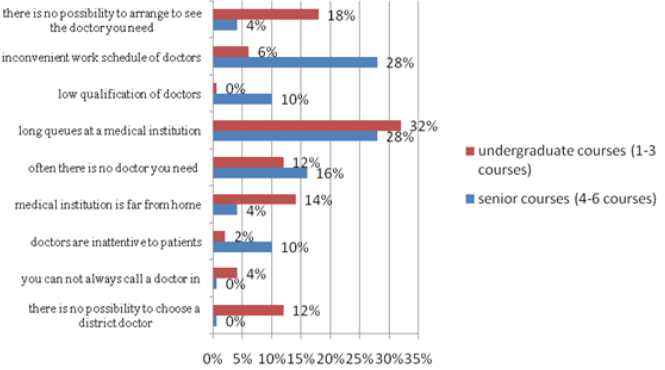
Source: based on the sociological survey.
As Figure 3 demonstrates, undergraduate and senior students pay attention to different characteristics of free medical care. Young people were unanimously dissatisfied with the only indicator which was long queues in medical institutions (28% of senior students and 32% of undergraduate students). In addition to this characteristics, students of the 1-3 years are not satisfied with the fact that “there is no opportunity to arrange to see the specialist you need” (18%) and “medical institution is far from home” (14%). Senior students are not satisfied with “inconvenient doctors’ time-tables” (28%) and “often there is no doctor you need” (16%). Senior students tend to appreciate more the shortest periods of stay in a medical institution, perhaps this is because they have to work alongside with their studies, especially in senior years. It is also noteworthy, that older students pay more attention to such characteristics of free medicine as qualifications of doctors and their attitude towards patients.
The data from a pilot study on the problems of satisfaction with the quality of free medical care were compared to the results of 2011 student´s health survey in Ufa. It was found out that students demonstrate low satisfaction with free medical care and they pay attention to long queues in medical institutions (28.2%), inattention of doctors (16%), low qualifications of doctors (18.4%), i.e. they denote the most acute problems of free health care. The trend generally remains.
Only 16% of the respondents have applied for medical assistance. The degree of satisfaction with paid services in medical institutions is generally high. 88% of the respondents who applied for paid medical care were satisfied with the result.
The following conclusions can be made on the basis of the results of the authors survey: 1) Young males are mostly not interested in additional information on the ways of maintaining their health. Girls, on the contrary, believe that they need additional information on health. For girls, information on such items as “proper nutrition” (16%), “healthy lifestyle” (20%), and “psychology of communication” (22%) is more topical. For young men, the most pressing problems of healthy lifestyle, for which they tried to obtain additional information, were: “cold acclimation” (10%), “healthy lifestyle” (14%), “how to get rid of bad habits” (20%).
2) The sources from which the respondents obtained information about health for the last time were revealed in the course of the survey. The Internet was the most popular source of information about health (44%). The second most common answer was television (20%). The third one was “Conversations with relatives and friends” (16%). None of the students reported “At the university lecture (another educational institution)”.
3) It has been established that a significant proportion of the respondents seek medical care either when they feel bad for several days, or when they need a medical certificate (medical examination certificate, sick-leave, etc.)
4) Students show low degree of satisfaction with free medicine. Over half of the respondents (52%) are partially satisfied with it. Only 8% of the respondents are completely satisfied with free medical care. 32% of the respondents are not satisfied with free medical care. Long queues in medical institutions, inattention of doctors, and low level of doctors’ qualification are the main problems of free medicine, as reported by the respondents.
Nowadays youth health protection can be provided only through a comprehensive approach involving other social institutions, besides health care. Institutional mechanisms of health protection are needed. However, presently, these mechanisms address only some aspects of the problem. They are unable to cover the whole problem and can sometimes produce a dysfunctional effect.
Abaskalova, N. P. (2001). Systematic approach to the formation of a healthy lifestyle of the subjects of the educational process (school - university): Monograph.
Akchurin, B. G. (2006). Spiritual, historical and socio-cultural foundations of human health. The Academy of Sciences of the Republic of Bashkortostan, the Department of social and human sciences. Ufa: Gilem.
Amosov, N.M. (1987). Thinking about health. Moscow: Enlightenment.
Avdeeva, N. N., Ashmarin, I. I., Stepanova, G. B. (2000). Health as a value and subject of scientific knowledge. World of psychology, 1 (21).
Averin, A. N. (2008). Social policy of federal bodies of the state power: study guide. Moscow: RAGS publishing.
Bezrukikh, N.A. (2007). Formation of students’ orientation on healthy lifestyle in the educational process of vocational school. Saratov: Povolzh. AGS.
Gaisina, L.M., Bakhtizin, R.N., Mikhaylovskaya, I.M., Khairullina, N.G., Belonozhko, M.L. (2015). Social technologies as an instrument for modernization of social space in the social and labor sphere. Biosciences Biotechnology Research Asia, 12(3), 2947-2958.
Gaisina, L.M., Barbakov, O.M., Koltunova, Yu.I., Shakirova, E.V., Kostyleva, E.G. (2017). Social management systems’ modeling based on synergetic approach: methods and fundamentals of implementation. Academy of Strategic Management Journal, 16(Special Issue 1), 83-95.
Gaisina, L.M., Belonozhko, M.L, Tkacheva, N.A., Abdrakhmanov, N. Kh, Grogulenko, N.V. (2017). Principles and methods of synergy modeling of management system at oil and gas sector’s enterprises. Espacios, 38(33), 5.
Gaisina, L.M., Mikhaylovskaya, I.M., Khairullina, N.G., Ustinova, O.V., Shakirova, E.V. (2015). The role of the media in the spiritual and moral evolution of society. Mediterranean Journal of Social Sciences, 6(5(S2)), 93-101.
Gorokhova, A. E., Gaisina, L. M., Gareev, E. S., Shutov, N. V., Shakirova, E. V. (2018). Application of coaching methods at agricultural and industrial enterprises to improve the quality of young specialists’ adaptation. Quality - Access to Success, 19(164), 103-108.
Popov, A.V., Schneider, O.S. (2012). Healthy lifestyle of students: study guide. Khabarovsk: DVGUPS publishing.
Sekerin, V. D., Gaisina, L. M., Shutov, N. V., Abdrakhmanov, N. Kh., Valitova, N. E. (2018). Improving the quality of competence-oriented training of personnel at industrial enterprises. Quality - Access to Success, 19(165), 68-72.
Shayahmetova R.R. (2017) General philosophical concept of health and self-caring behaviour. Eurasian law journal. 11(114), 444-446.
Vardomatsky, A. P. (1989). Place of creativity in a series of vital values of students. Moscow.
Zhuravlev, I. V. (2012). Students’ health: sociological analysis. The Institute of sociology. Moscow.
1. Ufa State Petroleum Technological University, 450062, Russia. E-mail: gaisina.l.m@mail.ru
2. Bashkir State University, 450076, Russia
3. Bashkir State University, 450076, Russia
4. Ufa State Petroleum Technological University, 450062, Russia
5. Bashkir State Agrarian University, 450001, Russia
6. Ufa State Petroleum Technological University, 450062, Russia